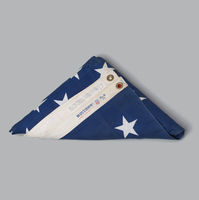
The U.S. Senate Collection includes thousands of fascinating and historic artifacts, but two in particular could be considered “out of this world!” These items—a 1969 United States flag and a 1993 printing of Thomas Jefferson’s A Manual of Parliamentary Practice—have flown to space on historic missions led by the National Aeronautics and Space Administration (NASA) and are now under the care of the Office of Senate Curator. Together, these objects evidence the Senate’s support for space exploration and research and serve as tangible reminders of the first crewed lunar landing and NASA’s space shuttle program.
Perhaps the most famous U.S. flag associated with the space program is the one astronauts Neil Armstrong and Edwin “Buzz” Aldrin planted on the Moon on July 21, 1969. Approximately 650 million viewers worldwide tuned into live television to watch Armstrong’s and Aldrin’s first steps on the lunar surface. So momentous was this event that, in 1972, the U.S. Senate Commission on Art, under the leadership of Senator Mike Mansfield of Montana, directed the creation of a mural commemorating the mission for the Senate wing of the U.S. Capitol. Artist Allyn Cox completed the mural America’s First Moon Landing, July 21, 1969, in his studio, and the work was approved and installed in the Brumidi Corridors in April 1975.1
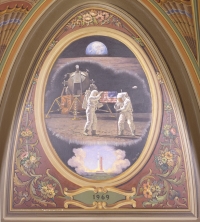
The three vignettes that comprise Cox’s mural—the Apollo 11 launch from Kennedy Space Center on July 16, 1969, at the bottom; the flag planting on the Moon on July 21, 1969, at the center; and the view of “Earthrise” at the top—intertwine themes of technological and scientific progress with national cooperation and commitment and signal their global implications. The Apollo 11 moon landing was the realization of President John F. Kennedy’s vision, stated in an address to a joint session of Congress on May 25, 1961, that the United States “should commit itself to achieving the goal, before this decade is out, of landing a man on the moon and returning him safely to earth.” Kennedy appealed to national pride when requesting that Congress fund the effort, adding, “But in a very real sense, it will not be one man going to the moon—we make this judgment affirmatively—it will be an entire nation. For all of us must work to put him there.” Prominently portrayed at the center of Cox’s mural, the U.S. flag signals the importance of U.S. government support and investment in making the endeavor a success.2
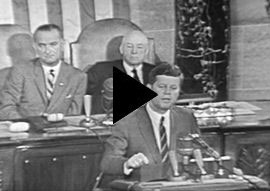
In addition to the U.S. flag famously planted on the lunar surface by Armstrong and Aldrin and pictured in the center of Cox’s mural, the Apollo 11 astronauts brought with them two flags that had previously flown over the U.S. Capitol. The one now in the U.S. Senate Collection flew over the Senate wing, traveled to space with Apollo 11, and was presented to Vice President Spiro Agnew by astronaut Michael Collins at a joint meeting of Congress on September 16, 1969. Armstrong presented the other flag, which had flown over the House of Representatives wing of the Capitol, to Speaker John McCormack. At the joint meeting, Armstrong credited Congress with making the Apollo 11 mission possible, declaring, “It was here in these Halls that our venture really began. Here the Space Act of 1958 was framed, the chartering document of the National Aeronautics and Space Administration. And here in the years that followed the key decisions that permitted the successive steps of Mercury and Gemini and Apollo were permitted.”3
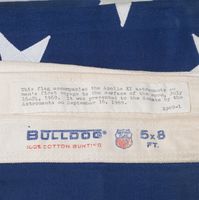
The flag presented by Collins to Vice President Agnew is a seemingly ordinary, cotton flag measuring five feet high and eight feet wide and manufactured by the Dettra Flag Company, but its involvement in the Apollo 11 spaceflight makes it extraordinary. Vice President Agnew acknowledged its importance when he accepted the flag, promising, “I can assure you that this memento … will be kept and appreciated with the dignity that it deserves.” The flag was turned over to the secretary of the Senate, who then delivered it to the curator of art and antiquities of the Senate for safekeeping. To satisfy the curious public, the flag was exhibited at the Capitol until the summer of 1970. After it came off view, the Senate Upholstery Shop sewed a cloth label onto the flag that identifies the object and its historic significance.4
Nearly three decades after the Apollo 11 astronauts gifted to the U.S. Senate a flag that had flown to the Moon, another artifact of space history was presented to the Senate: a hardbound 1993 printing of Thomas Jefferson’s A Manual of Parliamentary Practice. Senator John Glenn of Ohio, a former NASA astronaut, brought the book on the space shuttle Discovery for his final voyage to space. Prior to joining the Senate, Glenn had made history as the first American to orbit Earth, circling three times during a nearly five-hour flight aboard the Friendship 7 space capsule on February 20, 1962. He set another record in 1998, when, at age 77, he became the world’s oldest person to fly in space, joining mission STS-95 as a payload specialist and subject for basic research to study how weightlessness affects the body of older persons.5
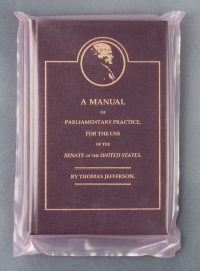
Each crew member on the STS-95 mission was permitted to sponsor items to travel into space as part of the Official Flight Kit (OFK), a container measuring approximately two cubic feet that is “reserved for carrying official mementos of NASA and other organizations aboard Space Shuttle flights.” NASA requires mementos to be “of little commercial value” and small enough to fit in the shuttle’s OFK. After consultation with staff in the Office of Senate Curator, the Senate Historical Office, and the Senate Library, Senator Glenn selected this Manual of Parliamentary Practice for the STS-95 OFK. In sponsoring an OFK item for the U.S. Senate, Glenn recognized Congress’s history of support for the space shuttle program.6
The Manual of Parliamentary Practice was a practical choice because of its relatively small size and weight, but it is also a meaningful text in Senate history. While serving as vice president (1797–1801) and therefore as the presiding officer of the Senate, Jefferson compiled the manual to serve as a guide for legislative procedures. The cover of this 1993 printing features a profile portrait of Jefferson embossed in gold. In the months leading up to his vice-presidential inauguration in 1797, Jefferson reported feeling “entirely rusty in the Parliamentary rules of procedure” and set out to create a reference manual to support his rulings and to guide future presiding officers. After its publication in 1801, Jefferson deposited the book with the Senate, where it influenced the legislative body’s approach to order and decorum. The Manual also was integrated into the rules used by the House of Representatives.7
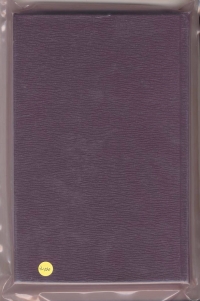
Following Glenn’s request to include the Manual as an OFK item, it arrived at the space center at least 45 days prior to the flight for processing. The book was listed on the cargo manifest, packaged and sealed in this light pink plastic sheath, weighed, and stowed aboard the Discovery space shuttle orbiter. A small yellow sticker on the back of the plastic packaging denotes the Manual’s number on the STS-95 OFK, #106. After the flight, the Manual was returned to Glenn. The accompanying certificate of authenticity, issued from NASA’s Lyndon B. Johnson Space Center, provides the official statistics of the spaceflight, reporting that STS-95 (and its OFK items, including the Manual) reached a maximum altitude of 355 miles, a maximum speed of 17,950 miles per hour, and traveled 3.6 million miles over the course of eight days, 21 hours, and 45 minutes between October 29 and November 7, 1998. On December 3, 1998, at an event at the National Air and Space Museum in Washington, D.C., Senator Glenn presented the Manual to Senate Minority Leader Thomas Daschle of South Dakota and Senator Richard Lugar of Indiana. The artifact was later accessioned into the U.S. Senate Collection.8
Toward the end of his term in the Senate, Glenn reflected on his dual careers as an astronaut and a legislator: “Both fields take a lot of dedication to accomplish anything. That would be a big similarity, dedication to country and dedication to what you’re doing. But that’s about where the similarities end.” Though the similarities of working in the two “fields” might be few, it is clear that their histories are intertwined. The U.S. Senate Collection includes artworks and artifacts that make visible some of these historical intersections and the role the Senate has played in supporting and celebrating space research. For more on these objects and others, please visit the Space and Aeronautics thematic collection on the Senate website. 9
Notes
1. “Apollo 11 Mission Overview,” NASA, last updated January 5, 2022, https://www.nasa.gov/mission_pages/apollo/missions/apollo11.html; William Kloss and Diane K. Skvarla, “America’s First Moon Landing,” in United States Senate Catalogue of Fine Arts (Washington, D.C.: U.S. Government Printing Office, 2002), 16.
4. Congressional Record, 91st Cong., 1st sess., September 16, 1969, 25611, 25577; Letter from Richard Baker (then Senate curator) to Francis R. Valeo (secretary of the Senate), December 10, 1969, in the files of the Office of Senate Curator. According to an unsigned, handwritten note on Office of the Secretary stationary, dated September 25, 1970, and located in Office of Senate Curator files, the label was applied to the flag that month.
5. “Profile of John Glenn,” NASA, accessed June 23, 2023, https://www.nasa.gov/content/profile-of-john-glenn.
6. 14 C.F.R. 90 § 1214.601 (1998); Memorandum from Diane K. Skvarla (Senate curator) to Sebastian O’Kelly (staff member serving Sen. Glenn as chairman of the Committee on Governmental Affairs), June 26, 1998, in the files of the Office of Senate Curator. This support began with the approval of $78.5 million dollars for shuttle research and development in fiscal year 1971. See: Migdon R. Segal, “The Space Shuttle: A Historical Overview,” Congressional Research Service, 73-123 SP, July 5, 1973, 13.
7. Wilbur Samuel Howell, ed., Jefferson’s Parliamentary Writings: “Parliamentary Pocket-Book” and A Manual of Parliamentary Practice, The Papers of Thomas Jefferson, 2nd series (Princeton: Princeton University Press, 1988), 9; Gaye Wilson, “Manual of Parliamentary Practice,” Thomas Jefferson Encyclopedia, accessed June 5, 2023, https://www.monticello.org/research-education/thomas-jefferson-encyclopedia/manual-parliamentary-practice/; Senate Historical Office, “Idea of the Senate | The Senate's Rules,” accessed June 5, 2023, https://www.senate.gov/about/origins-foundations/idea-of-the-senate/1801Jefferson.htm.
8. 14 CFR 90 § 1214.605 (1998); “STS-95,” Space Shuttle Mission Archives, NASA, accessed June 23, 2023, https://www.nasa.gov/mission_pages/shuttle/shuttlemissions/archives/sts-95.html; Ed Henry, “Heard on the Hill. Glenn’s Goodbye,” Roll Call, December 7, 1998.